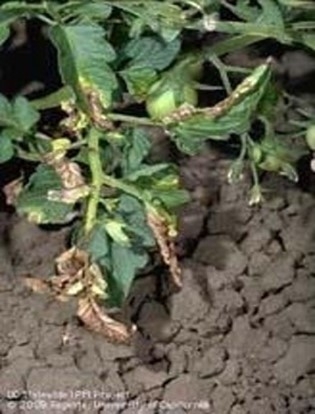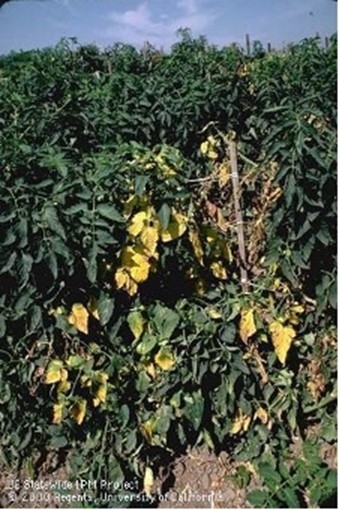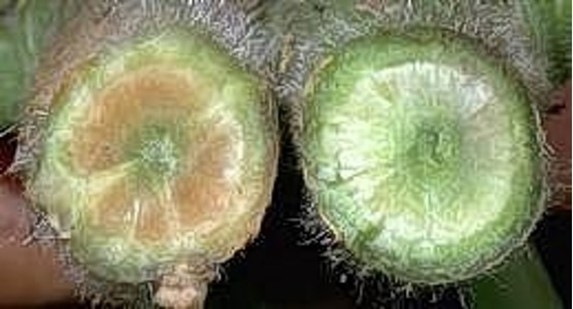Do your tomato plants suffer from lack of vigor, yellowing leaves, and poor fruit production? These symptoms are associated with many different problems, including lack of soil nutrients, excess salts in the soil or irrigation water, poor drainage or waterlogged soil, or a variety of plant diseases.
Trying to figure out what has gone wrong in your garden may not sound like much fun, but it is a necessary and important part of gardening. The more information we have, the easier it is to diagnose the problem when our hopes for a bountiful garden turn to disappointment. A gardener may change how they care for ailing plants by applying more or less water, fertilizing, or even spraying with pesticides or fungicides. Often nothing they do makes a difference, the plants continue to fail, and many eventually wither and die.
If this describes your experience growing tomatoes, you may find that a wilt disease could be the culprit. Armed with the information in this article, you can determine whether a wilt disease is a problem in your garden.
What is a wilt disease?
Verticillium wilt and Fusarium wilt, also called vascular wilt diseases, are soil-borne fungal diseases that infect susceptible plants through the roots, growing into and plugging the water-conducting (vascular) tissues. This causes the plant to be unable to take up sufficient water needed for healthy growth. Verticillium and Fusarium cause similar symptoms in their hosts.
Once these pathogens are in the soil, they are difficult to manage as they can survive in the soil for many years and possibly decades without living host plants. There is nothing that can be done for plants that are already infected with either Verticillium or Fusarium wilt. There are no fungicides available for application to the plants that can be used to control these diseases.
Verticillium wilt is widespread and very destructive and is common in our area. It is estimated that over 300 plant species throughout the world are susceptible. The pathogen responsible for the disease in tomato plants is Verticillium dahliae. This fungus favors moist soil and relatively cool (55–75° F) soil temperatures.
Early symptoms include a progressive yellowing of older leaves and wilting of shoot tips at the top of the plant during the warm part of the day.
Later, leaf margins curl upward, and leaves often drop off. Any fruit produced is usually small. The wilting becomes progressively worse, and although plants may not die, their condition can be so poor that it is not worth the effort to try to keep them going. Verticillium wilt will also infect several other common garden plants.
The list is a long one, and includes many garden vegetables as well as shrubs, trees and ornamentals. Below are links to lists of plants that are susceptible to Verticillium and Fusarium wilt.

Fusarium wilt presents with symptoms that, while not identical, are quite similar to Verticillium wilt. Although it is not as widespread as Verticillium, Fusarium is also a common disease in tomatoes. It differs from Verticillium wilt in that the Fusarium oxysporum pathogen has several forms which are host-specific. This means that the specific Fusarium fungi, Fusarium oxysporum f.sp. lycopersici, only causes disease in tomato plants.
Unlike Verticillium wilt which has a very wide host range, the strain of Fusarium that infects tomatoes will not cause disease in other plant species. It can infect many different non-tomato crops, including melons, pepper, and sunflowers without causing any symptoms, and will persist in both tomato and non-tomato plant residue in soil. Infection and disease development in Fusarium wilt are favored by warm soil temperatures (80° F) and low soil moisture.
The symptoms of this disease are bright yellow leaves that commonly appear first on just one side or one branch of a plant. The leaf symptoms will also often appear as yellowing on just one side of a leaf, delineated by the central vein. These symptoms are distinctive and can be very helpful in making a diagnosis. The foliage yellows, wilts, then turns brown and dies. Older leaves are affected first, followed by death of the entire plant.

Disease confirmation
To confirm the diagnosis of a wilt disease, cut open one of the lower stems of the affected plant. If the vascular tissue inside the stem has turned brown or darkened (in contrast to the white or pale green color inside a healthy stem), it is a good indication that the plant has one or the other of these fungal diseases.
If you confirm the presence of the disease, you should remove the infected plant (including as much of the roots and plant debris as possible) and dispose of it in the garbage or your green waste bin. Don't compost it yourself since home compost piles rarely reach and maintain temperatures hot enough to kill the disease pathogens.

How did this disease get into my garden?
Both Fusarium and Verticillium fungi can be introduced on infected transplants, seeds, and tubers, or spread on equipment contaminated with infected soil. Wood chip mulch that comes from an infected tree can also spread the Verticillium fungi from one area to another. Because it can also survive in the digestive tract of horses and other animals who have consumed infected plant material, animal manures can sometimes be another source.
What steps can I take to keep these diseases from spreading throughout my garden?
- Do not transplant plants from one area to another. Moving soil, even a very small amount, can spread the disease.
- The fungi can also be transported on equipment such as shovels, trowels, etc. Thoroughly clean and disinfect tools used in the infected garden bed before using them in other areas of your yard or garden. First wash or brush off any soil or plant debris, then disinfect your tools with alcohol. You can either wipe or dip them in a solution that is 70–100% alcohol. Isopropyl alcohol is widely available and can easily be found in many stores.
- More on products used to sterilize garden tools, and their pros and cons: https://gardeningsolutions.ifas.ufl.edu/care/tools-and-equipment/disinfecting-tools.html
I suspect that I may have a wilt disease in my garden. Will I still be able to grow tomatoes and other vegetables?
Choosing disease resistant tomato varieties is a way for gardeners to prevent the losses due to wilt diseases. Many disease-resistant hybrid tomato plant varieties have been developed and are available to the home gardener. They can be found at our yearly Great Tomato Plant Sale, in seed catalogs, and at local garden centers. The letters V and F following the variety name in seed catalogs, on seed packets, or plant labels denote varieties that are resistant to Verticillium and Fusarium wilts.
It is unfortunate that nearly all heirloom tomato varieties are susceptible to wilt disease. Heirloom tomato varieties would be better grown in containers with fresh potting mix or in a garden area that has not developed the pathogens (for example, an area in which you have never previously grown tomatoes or other crops that are vulnerable to the wilt diseases).
In addition to tomatoes, several vegetable plants including peppers, eggplants, potatoes, squash, and melons can suffer from Verticillium wilt. The Fusarium fungus specific to tomatoes will only affect tomatoes and will not cause disease in other vegetables. If you plan to grow other vegetables in the same garden bed where a tomato plant suspected of having Verticillium wilt has grown. Check the links below or do an internet search to determine whether the variety you want to grow is susceptible to the wilt diseases. For example, you can search “is broccoli susceptible to Verticillium wilt?”
Soil solarization is another method that can be used to reduce the amount of these pathogens in the soil. It involves heating the soil by covering it with clear plastic for four to six weeks during the summer. It is most effective when day length at its longest, and temperatures are high.
Links to additional information:
• Soil solarization: https://ipm.ucanr.edu/PMG/PESTNOTES/pn74145.html
• Verticillium wilt: http://ipm.ucanr.edu/PMG/GARDEN/VEGES/DISEASES/tomvertwilt.html
• Fusarium wilt: https://ipm.ucanr.edu/PMG/GARDEN/PLANTS/DISEASES/fusariumwlt.html
• Plants resistant or susceptible to Verticillium wilt: https://depts.washington.edu/hortlib/resources/ucdavis_verticillium.pdf
• Plants susceptible to Fusarium wilt: https://extension.usu.edu/pests/research/fusarium-verticillium-wilts
To find great gardening info, a list of previous blog postings, and information on our Great Tomato Plant Sale go to our website: https://ccmg.ucanr.edu/
Help Desk of the UC Master Gardeners of Contra Costa County (SMH)